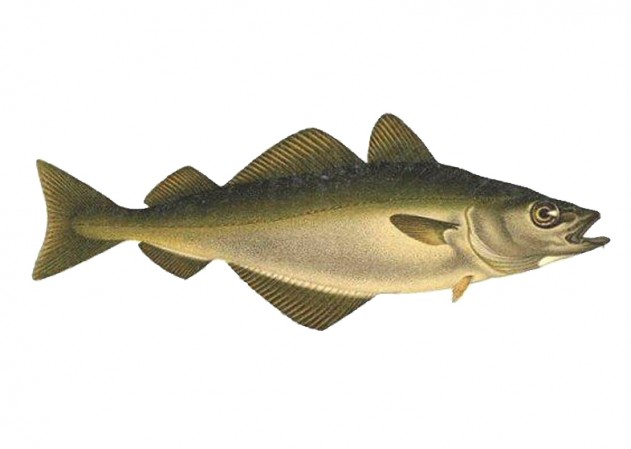Description:
A member of the cod family, pollock is a long, thin, big-eyed fish ranging from 4 to 35 lbs. They have a small chin barbel, like the whiskers on a catfish. It is distinguished from its cousins by its greenish hue, by having a pointed snout and a projecting lower jaw, a more rounded body, and a forked rather than a square tail. The Atlantic pollock is olive green above, paling on the lower sides to a yellow-gray, and finally to silver gray on the belly. Its lateral line is white, and it has a small barbel on its chin. Pollock averages 4 to 15 pounds (1 to 7 kg) and 2 to 3 feet (50 to 90 cm) long and can grow to 40 pounds. Atlantic pollock are brownish-green on the back and slightly paler on the belly.
Habitats
Atlantic pollock adults show little preference for bottom type. They are found at high salinities, 31-34 ppt, and temperatures of 0-14 C, although they tend to avoid temperatures > 11 C and < 3 C. They inhabit a wide range of depths, 35-365 m, but most occur within the 137 m depth contour and depths of 100-125 m are preferred. Adults tend to inhabit deeper waters in spring and summer than in winter and they are typically found further offshore than juveniles. Pollock initially inhabit the water column and therefore feed on pelagic prey. The primary prey of small larvae (4-18 mm) are larval copepods while larger larvae (> 18 mm) feed primarily on adult copepods. The primary prey of juvenile pollock are crustaceans. Euphausiids, in particular Meganyctiphanes norvegica, are the most important crustacean prey of juveniles. Fish and mollusks make up a smaller proportion of the juvenile diet; however, in some cases fish may play a more important role in the diet. The diet of adults is comprised of, in order of decreasing importance, euphausiids, fish and mollusks. Norvegica is the single most important prey item and Atlantic herring is the most important fish species.
Spawning:
Male pollock reach sexual maturity at 58 cm and 4-7 years, at a larger size and older age than females, 62.5 cm and 5-7 years. Spawning takes place from September to April, when the water column cools to near 8 C, and peaks when temperatures are approximately 4.5-6 C. Most spawning occurs within a comparatively narrow range of temperatures. Spawning time is more variable in northern sites than in southern sites. In the Gulf of Maine spawning occurs from November to February, peaking in December. On the Scotian Shelf, spawning occurs from September to April and peaks from December to February. Spawning occurs over hard, stony or rocky bottom.
Pollock eggs are spawned over broken substrate at salinities of 32-32.8 ppt. They are pelagic and free-floating, usually are in water 50-250 m in depth. Larvae are also pelagic, commonly found at temperatures of 3-9 C, and normally occur from the shore out to the 200 m depth contour, but could be in waters as deep as 1550 m. Juveniles are seen over a wide variety of substrates, including sand, mud, or rocky bottom and vegetation. They are found at temperatures ranging from 0-16 C and prefer salinities of around 31.5 ppt. Inshore subtidal and intertidal zones are utilized by age 0+ and 1+ juveniles and serve as important nursery areas. Age 2+ juveniles move offshore, inhabiting depths of 130-150 m.

